technical specifications Alfa Romeo 156 2006 Owner handbook (in English)
[x] Cancel search | Manufacturer: ALFA ROMEO, Model Year: 2006, Model line: 156, Model: Alfa Romeo 156 2006Pages: 357, PDF Size: 5.04 MB
Page 7 of 357
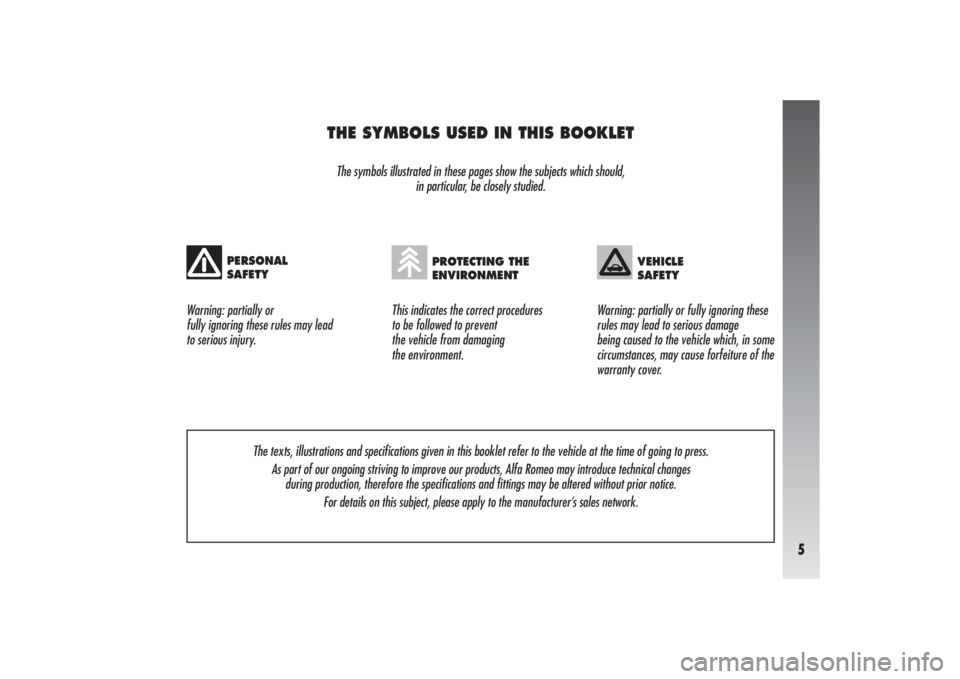
5
THE SYMBOLS USED IN THIS BOOKLETThe symbols illustrated in these pages show the subjects which should,
in particular, be closely studied.
This indicates the correct procedures
to be followed to prevent
the vehicle from damaging
the environment. Warning: partially or
fully ignoring these rules may lead
to serious injury.Warning: partially or fully ignoring these
rules may lead to serious damage
being caused to the vehicle which, in some
circumstances, may cause forfeiture of the
warranty cover.
PERSONAL
SAFETY
PROTECTING THE
ENVIRONMENT
VEHICLE
SAFETY
The texts, illustrations and specifications given in this booklet refer to the vehicle at the time of going to press.
As part of our ongoing striving to improve our products, Alfa Romeo may introduce technical changes
during production, therefore the specifications and fittings may be altered without prior notice.
For details on this subject, please apply to the manufacturer’s sales network.
Page 85 of 357
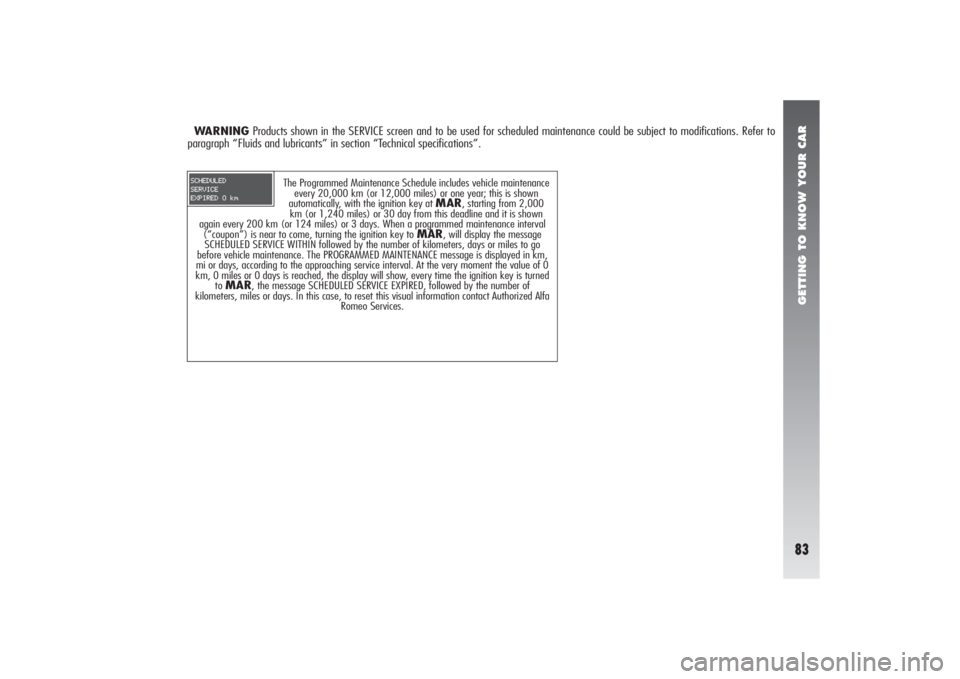
GETTING TO KNOW YOUR CAR83
The Programmed Maintenance Schedule includes vehicle maintenance
every 20,000 km (or 12,000 miles) or one year; this is shown
automatically, with the ignition key at
MAR
, starting from 2,000
km (or 1,240 miles) or 30 day from this deadline and it is shown
again every 200 km (or 124 miles) or 3 days. When a programmed maintenance interval
(“coupon”) is near to come, turning the ignition key to
MAR
, will display the message
SCHEDULED SERVICE WITHIN followed by the number of kilometers, days or miles to go
before vehicle maintenance. The PROGRAMMED MAINTENANCE message is displayed in km,
mi or days, according to the approaching service interval. At the very moment the value of 0
km, 0 miles or 0 days is reached, the display will show, every time the ignition key is turned
to
MAR
, the message SCHEDULED SERVICE EXPIRED, followed by the number of
kilometers, miles or days. In this case, to reset this visual information contact Authorized Alfa
Romeo Services.
WARNINGProducts shown in the SERVICE screen and to be used for scheduled maintenance could be subject to modifications. Refer to
paragraph “Fluids and lubricants” in section “Technical specifications”.
Page 141 of 357
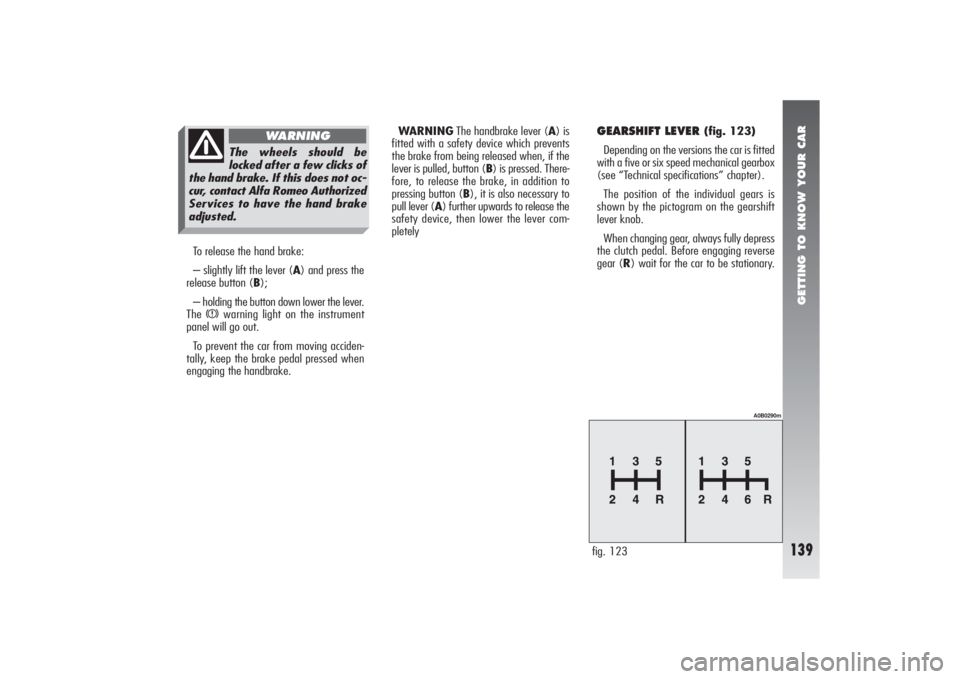
GETTING TO KNOW YOUR CAR
139
To release the hand brake:
– slightly lift the lever (A) and press the
release button (B);
– holding the button down lower the lever.
The
x
warning light on the instrument
panel will go out.
To prevent the car from moving acciden-
tally, keep the brake pedal pressed when
engaging the handbrake.WARNINGThe handbrake lever (A) is
fitted with a safety device which prevents
the brake from being released when, if the
lever is pulled, button (B) is pressed. There-
fore, to release the brake, in addition to
pressing button (B), it is also necessary to
pull lever (A) further upwards to release the
safety device, then lower the lever com-
pletely
GEARSHIFT LEVER
(fig. 123)
Depending on the versions the car is fitted
with a five or six speed mechanical gearbox
(see “Technical specifications” chapter).
The position of the individual gears is
shown by the pictogram on the gearshift
lever knob.
When changing gear, always fully depress
the clutch pedal. Before engaging reverse
gear (R) wait for the car to be stationary.
fig. 123
A0B0290m
The wheels should be
locked after a few clicks of
the hand brake. If this does not oc-
cur, contact Alfa Romeo Authorized
Services to have the hand brake
adjusted.
WARNING
Page 204 of 357
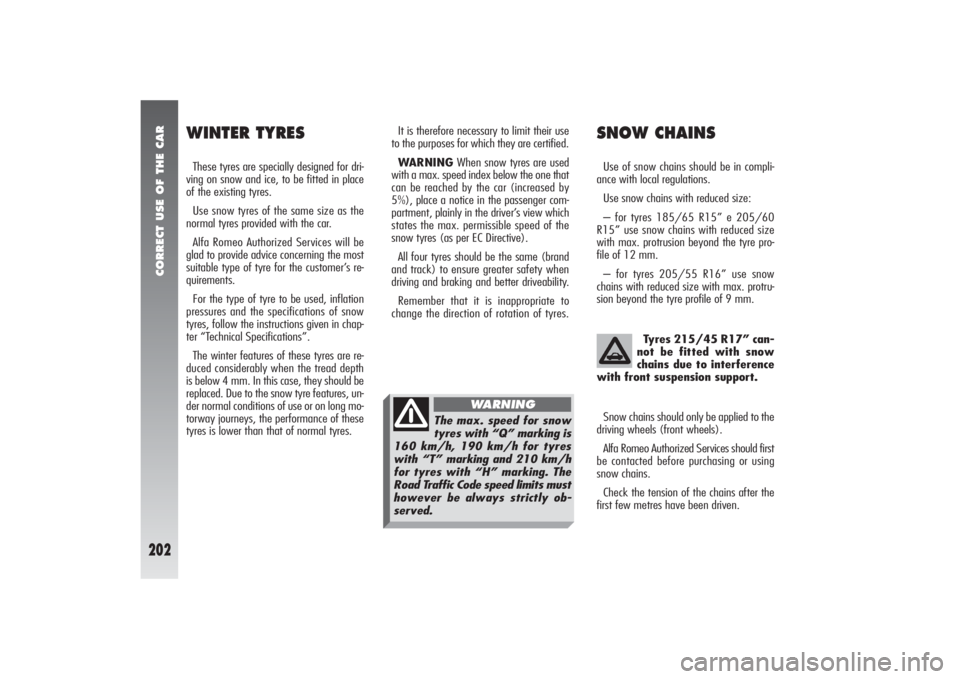
CORRECT USE OF THE CAR
202
It is therefore necessary to limit their use
to the purposes for which they are certified.
WARNINGWhen snow tyres are used
with a max. speed index below the one that
can be reached by the car (increased by
5%), place a notice in the passenger com-
partment, plainly in the driver’s view which
states the max. permissible speed of the
snow tyres (as per EC Directive).
All four tyres should be the same (brand
and track) to ensure greater safety when
driving and braking and better driveability.
Remember that it is inappropriate to
change the direction of rotation of tyres.
WINTER TYRESThese tyres are specially designed for dri-
ving on snow and ice, to be fitted in place
of the existing tyres.
Use snow tyres of the same size as the
normal tyres provided with the car.
Alfa Romeo Authorized Services will be
glad to provide advice concerning the most
suitable type of tyre for the customer’s re-
quirements.
For the type of tyre to be used, inflation
pressures and the specifications of snow
tyres, follow the instructions given in chap-
ter “Technical Specifications”.
The winter features of these tyres are re-
duced considerably when the tread depth
is below 4 mm. In this case, they should be
replaced. Due to the snow tyre features, un-
der normal conditions of use or on long mo-
torway journeys, the performance of these
tyres is lower than that of normal tyres.
SNOW CHAINSUse of snow chains should be in compli-
ance with local regulations.
Use snow chains with reduced size:
– for tyres 185/65 R15” e 205/60
R15” use snow chains with reduced size
with max. protrusion beyond the tyre pro-
file of 12 mm.
– for tyres 205/55 R16” use snow
chains with reduced size with max. protru-
sion beyond the tyre profile of 9 mm.
Tyres 215/45 R17” can-
not be fitted with snow
chains due to interference
with front suspension support. Snow chains should only be applied to the
driving wheels (front wheels).
Alfa Romeo Authorized Services should first
be contacted before purchasing or using
snow chains.
Check the tension of the chains after the
first few metres have been driven.
The max. speed for snow
tyres with “Q” marking is
160 km/h, 190 km/h for tyres
with “T” marking and 210 km/h
for tyres with “H” marking. The
Road Traffic Code speed limits must
however be always strictly ob-
served.
WARNING
Page 211 of 357

IN AN EMERGENCY
209
CHANGING A WHEEL(optional for versions/markets
where applicable)
You are informed that:
– The jack mass is 2,100 kg.
– The jack requires no adjustment.
– The jack cannot be repaired, in the event
of breakage it must be replaced by anoth-
er original one.
– No tools other than its operating crank
can be fitted to the jack.
To change the wheel proceed as follows:
– Stop the car in such a position that it is
not dangerous for the traffic, where it is pos-
sible to change the wheel safely. Where pos-
sible, park on a level, compact surface.– Stop the engine and engage the hand-
brake.
– Engage first gear or reverse.
– Lift the boot carpet and hook it as shown
in (fig. 1a).
– Loosen the clamping device (handle)
(A-fig. 2).
fig. 2
A0B0234m
fig. 1a
A0B0577m
Snow chains cannot be fit-
ted to the compact spare
wheel, so, if a front wheel is punc-
tured and chains need to be used,
the front axle should be fitted with
normal wheels and the spare
wheel fitted to the rear. In this
way, as two normal tyres are fit-
ted to the front of the vehicle,
snow chains can be mounted,
thereby overcoming an emergency.
Absolutely never tamper with the
inflation valve.
Do not insert tools of any kind be-
tween the rim and the tyre.
Routinely check that the pressure
of the tyres and of the compact
spare wheel is as specified in the
“Technical specifications” chapter.
WARNING
Page 253 of 357
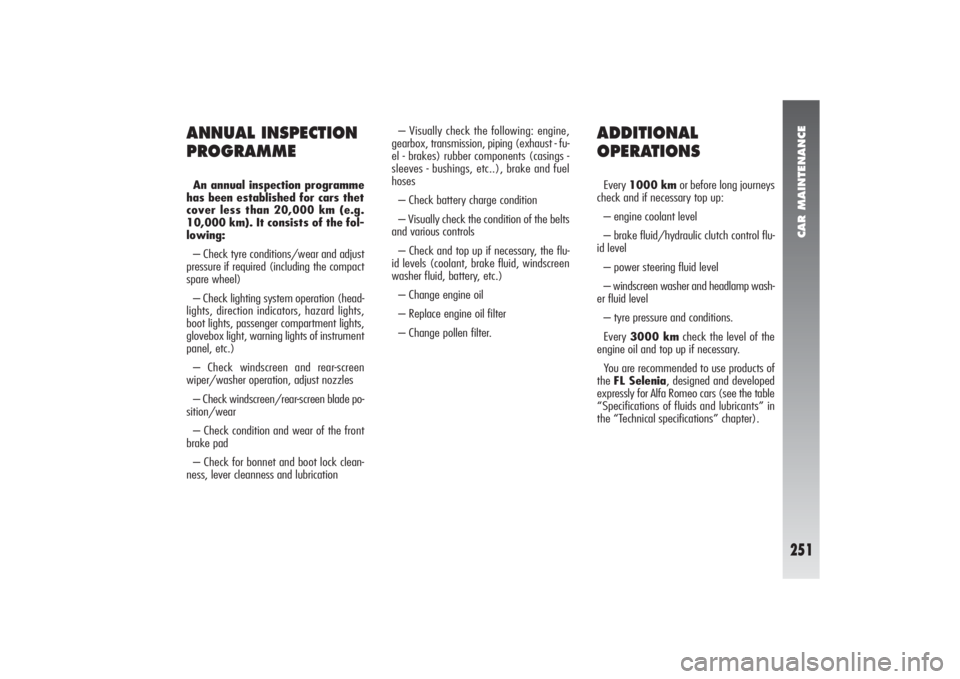
CAR MAINTENANCE
251
ADDITIONAL
OPERATIONSEvery 1000 kmor before long journeys
check and if necessary top up:
– engine coolant level
– brake fluid/hydraulic clutch control flu-
id level
– power steering fluid level
– windscreen washer and headlamp wash-
er fluid level
– tyre pressure and conditions.
Every 3000 kmcheck the level of the
engine oil and top up if necessary.
You are recommended to use products of
the FL Selenia, designed and developed
expressly for Alfa Romeo cars (see the table
“Specifications of fluids and lubricants” in
the “Technical specifications” chapter).
ANNUAL INSPECTION
PROGRAMMEAn annual inspection programme
has been established for cars thet
cover less than 20,000 km (e.g.
10,000 km). It consists of the fol-
lowing:
– Check tyre conditions/wear and adjust
pressure if required (including the compact
spare wheel)
– Check lighting system operation (head-
lights, direction indicators, hazard lights,
boot lights, passenger compartment lights,
glovebox light, warning lights of instrument
panel, etc.)
– Check windscreen and rear-screen
wiper/washer operation, adjust nozzles
– Check windscreen/rear-screen blade po-
sition/wear
– Check condition and wear of the front
brake pad
– Check for bonnet and boot lock clean-
ness, lever cleanness and lubrication– Visually check the following: engine,
gearbox, transmission, piping (exhaust - fu-
el - brakes) rubber components (casings -
sleeves - bushings, etc..), brake and fuel
hoses
– Check battery charge condition
– Visually check the condition of the belts
and various controls
– Check and top up if necessary, the flu-
id levels (coolant, brake fluid, windscreen
washer fluid, battery, etc.)
– Change engine oil
– Replace engine oil filter
– Change pollen filter.
Page 264 of 357

CAR MAINTENANCE
262
WARNINGContact Alfa Romeo Autho-
rized Services for maintenance and repair
operations. If the level of the oil in the reservoir falls
below the specified level, top up only with
one of the products listed in the table
“Fluids and lubricants” in the “Technical
specifications” chapter as follows:
– Start the engine and allow the oil in the
reservoir to settle.
– When the engine is running turn the
steering wheel lock to lock a few minutes.
– Top up to the MAXlevel notch and
then replace the cover.Oil consumption is very
low, if topping up again is
needed shortly afterwards,
have the system checked for pos-
sible leaks by Alfa Romeo Autho-
rized Services.fig. 19 fig. 18
A0B0158m
A0B0158m
POWER STEERING OIL LEVEL Fig. 17: T.SPARK versions
Fig. 18: 2.0 JTS versions
Fig. 19: 2.5 V6 24V and JTD versions
Check that the oil level in the reservoir is
at the MAX level.
This operation must be carried out with the
car on level ground and when the engine
is stationary and cold.
Check that the level reaches the MAXref-
erence notch on the reservoir or coincides
with the upper notch (maximum level) on
the dipstick integral with the reservoir cap.fig. 17
A0B0159m
Power steering fluid is
highly inflammable. Do not
let it come into contact with hot en-
gine parts.
WARNING
Page 273 of 357

CAR MAINTENANCE
271
WHEELS AND TYRESTYRES PRESSURECheck the pressure of each tyre, includ-
ing the compact spare wheel, every two
weeks and before a long journey.
The pressure should be checked with the
tyre rested and cold.
It is normal for the pressure to increase
when the car is in use. If you have to check
or restore the pressure when the tyres are
hot, bear in mind that the pressure should
be +0.3 bar compare with the specified rat-
ing.
For the correct tyre inflation pressure, see
“Wheels” in the “Technical specifications”
chapter.Incorrect pressure causes abnormal tyre
wear fig. 25:
A- Normal pressure: tread evenly worn.
B- Low pressure: tread particularly worn
at the edges.
C- High pressure: tread particularly worn
in the centre.
fig. 25
A0B0235m
WARNINGS
Where possible, avoid sudden braking, tyre
squealing starts, etc.
Particularly avoid violent bumps against
kerbs, potholes or obstacles of various kinds.
Prolonged driving on rough roads may dam-
age the tyres.
Routinely check the tyres for cuts on the
sides, swellings or uneven tread wear. If nec-
essary contact Alfa Romeo Authorized Ser-
vices.
Avoid overloading the vehicle when trav-
elling: this may cause serious damage to the
wheels and tyres.
If a tyre is punctured, stop immediately
and change it to avoid damage to the tyre,
the rim, suspensions and steering system.
Tyres age even if they are not used much.
Cracks in the tread rubber are a sign of ag-
ing. In any case, if the tyres have been on
the car for over 6 years, they should be
checked by specialised personnel, to see if
they can still be used. Also remember to
check the spare wheel.
Remember that car road
holding also depends on
correct tyre inflation pressure.
WARNING
Excessively low pressure
causes overheating of the
tyre with the possibility of serious
damage to it.
WARNING
Tyres should be changed when the tread
thickness is reduced to 1.6 mm. In any case
follow local regulations.
Page 286 of 357

ALFA 156 SPORTWAGON
284
fig. 19
A0B0092m
fig. 18
A0B0091m
ODDMENTS COMPARTMENT (fig. 18-19)
On the sides of the boot there are two re-
cesses closed by a lid.
To open the cover, press button (A) and
turn it downwards. As optional for ver-
sions/markets where applicable, the odd-
ment compartment on the left-hand side can
be provided with CD-Changer.
When using the boot, nev-
er exceed the maximum
permissible loads given in the
“Technical specifications” chapter.
Also make sure that the items con-
tained in the boot are firmly se-
cured, to prevent them being
thrown forward and harming the
passengers in the event of abrupt
braking.
WARNING
Heavy luggage without
restraints could cause se-
rious harm to the passengers in an
accident.
WARNING
If you want to carry fuel in
a reserve can, you should
comply with legal regulations, on-
ly using a certified can suitably fas-
tened to the load retainer rings at
the corner of the boot. However,
remember that this increases the
risk of fire in the event of an acci-
dent.
WARNING
Page 295 of 357
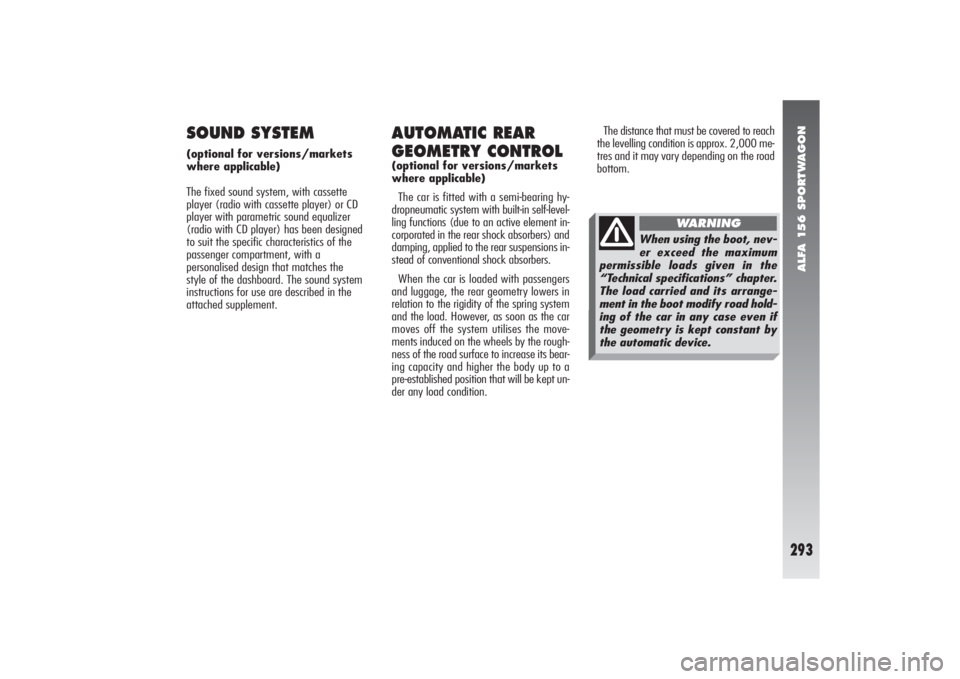
ALFA 156 SPORTWAGON
293
AUTOMATIC REAR
GEOMETRY CONTROL(optional for versions/markets
where applicable)
The car is fitted with a semi-bearing hy-
dropneumatic system with built-in self-level-
ling functions (due to an active element in-
corporated in the rear shock absorbers) and
damping, applied to the rear suspensions in-
stead of conventional shock absorbers.
When the car is loaded with passengers
and luggage, the rear geometry lowers in
relation to the rigidity of the spring system
and the load. However, as soon as the car
moves off the system utilises the move-
ments induced on the wheels by the rough-
ness of the road surface to increase its bear-
ing capacity and higher the body up to a
pre-established position that will be kept un-
der any load condition.
SOUND SYSTEM(optional for versions/markets
where applicable)
The fixed sound system, with cassette
player (radio with cassette player) or CD
player with parametric sound equalizer
(radio with CD player) has been designed
to suit the specific characteristics of the
passenger compartment, with a
personalised design that matches the
style of the dashboard. The sound system
instructions for use are described in the
attached supplement.The distance that must be covered to reach
the levelling condition is approx. 2,000 me-
tres and it may vary depending on the road
bottom.
When using the boot, nev-
er exceed the maximum
permissible loads given in the
“Technical specifications” chapter.
The load carried and its arrange-
ment in the boot modify road hold-
ing of the car in any case even if
the geometry is kept constant by
the automatic device.
WARNING